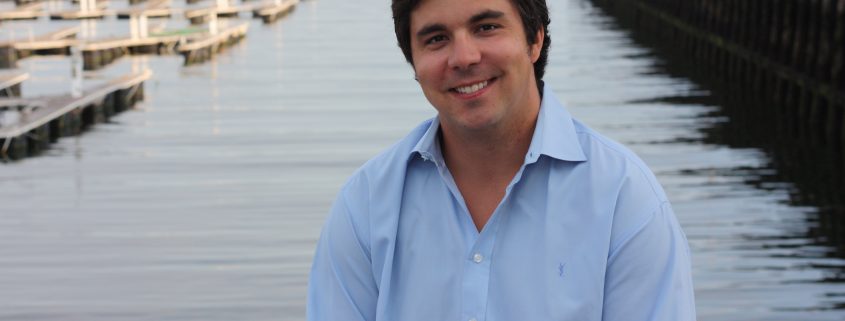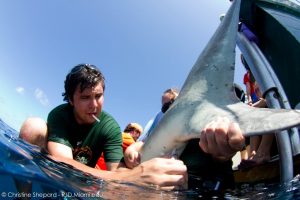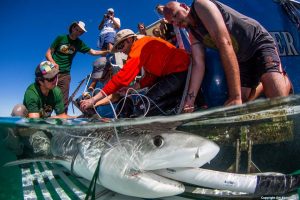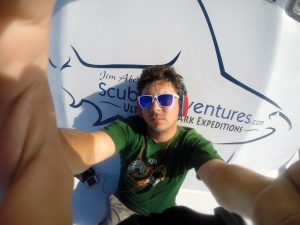Meet Our Team: Dr. Austin Gallagher
1. What’s your role in the lab?
I have been an active researcher in the lab since 2010 when I began my PhD program. Since then, I have been involved in several projects – some were central to my doctoral work on the vulnerability of sharks when they are captured in fisheries, while others were side-projects we hatched that focused on everything from evolutionary biology, to scavenging and nutritional physiology of mega-predators, and even the impacts of tourism on sharks. Most of my research focuses on the ecology of sharks, and I primarily rely on behavioral and eco-physiological approaches to answer my research questions. Currently I am leading and assisting on a variety research projects – some new, others expansive, which continue to focus on how sharks are able to survive their day-to-day lives, as well as how they are influenced by varying human threats. In this regard, I will continue to work with the lab for the foreseeable future as an associate researcher and I will also help develop and advance the work and trajectory of our graduate students.
2. Tell us a little about yourself.
Deep down I am a New Englander at heart, having been raised in and around the south shore of Boston and and Cape Cod, Massachusetts. In addition to my career as a scientist studying the conservation biology of predatory animals, I am also an entrepreneur. Most of my entrepreneurial interests are social, which is underscored by my role as the President of Beneath the Waves, a non-profit organization that focuses on advancing ocean conservation around the world. Our programs are diverse in terms of scientific and educational scope, and most of my effort is now focused on attracting and integrating other leaders and entrepreneurs from the music, film, business, and start-up worlds into specific causes and collaborations that promote our mission. I am a die-hard hockey fan, swearing my allegiance to the Boston Bruins NHL club. Nature photography and filmmaking are other hobbies of mine, as they pair well with my scientific endeavors. Lastly, I also DJ and produce electronic music in a group called “Natural Selection.” My goal with this latest endeavor is to create and perform tropical and sunset-driven tunes that transport people to a mindset that inspires passion, happiness, and success. I think it is really important to have at least one thing on the side that is completely different than the job you do everyday.
3. How did you get interested in marine biology and conservation?
I have always had sand in my bed and in my hair – literally. My family always encouraged me to explore and read, whether it was exploring tide pools near my home in Massachusetts, or humoring me when I would memorize everything in my animal books as a young kid. But truthfully, I have always been fascinated by animals that needed to kill for a living. Humans as a species have been disconnected with this notion for thousands of years, so I found great interest in trying to understand how predatory animals actually did this and made a living. The situation today with top predators (including sharks) is beautifully tragic: the still captivate us, yet they are being persecuted and removed unsustainably in terrestrial and marine ecosystems. When I began to learn about the growing conservation movement as an early adolescent, I saw an opportunity satiate my deep-rooted fundamental interests in marine predators and marry it with our society’s responsibility to preserve and maintain their biodiversity. I am humbled in the presence of predators – we have it so easy, and their situation is getting worse by the day. That is the space I work in: the interface between a crisis discipline/environmental issue and a deep-rooted, almost genetic interest and appreciation for the animals.
4. What’s your favorite part about working in the lab?
Working on top predators in the wild is especially challenging, but also incredibly rewarding. There is still a ton to learn about shark biology and ecology, and much of what we have been doing in the lab is either new to the study of predators in general or new for sharks. In this sense, I have particularly enjoyed borrowing techniques from the study of other species and adapting them for our shark work. Some of our expanding work on the nutritional physiology of sharks over space and time is an example of this. Yes, we all stand on the shoulders of giants, but I see these fields as wide open – there is a ton of room for innovation and collaboration that will result in trail-blazing research. For me, this makes research exciting, as we are constantly on the pulse of learning new things. There is always the potential for making groundbreaking discoveries that can change the way we view these incredible animals and how we can learn to improve our relationship with them.
5. Is there anything else you’d like to say to our readers?
Science is changing rapidly, from the way we conduct it, to the way we disseminate and communicate it. This is exciting, but it also shows that it is important to be adaptable and creative. I urge the public and readers of this and other marine conservation blogs to be open to change and embrace, engage, and interact with the conservation scientists that think outside the box, push the boundaries in the innovation of scientific methodologies, and openly communicate with the public about controversial policies or management scenarios.








Congrats on completing your doctoral work!